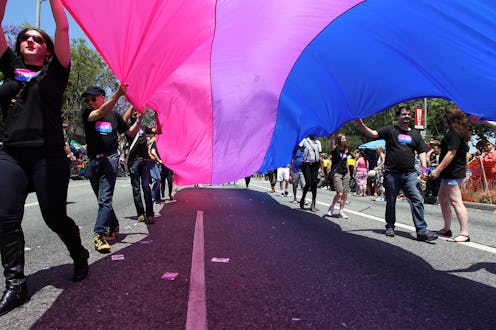Life
5 Myths About Bisexuality That Contribute To Bi Erasure

Through September 23, many people are celebrating Bisexual Awareness Week, which we still need because sadly, not enough people are truly aware of what it means to be bisexual. While bi people make up 52 percent of the LGBTQ community, they are sometimes excluded from the narrative at Pride festivals and LGBTQ celebrations because of biphobia and bi erasure. Bi erasure is a serious problem that isn't just promoted by straight people, but on occasion, by the non-bi queer community as well. Identifying as bisexual often feels like you're stuck in limbo — not “gay” enough for some, and not “straight” enough for others.
Many people believe the common misconception that bisexual is defined as being attracted to both men and women, and that when someone identifies as bi, they can't be attracted to non-binary folks. Bisexual people have tried to educate others about this issue in recent years. Modern day bi advocate and author Robyn Ochs defines bisexuality as “the potential to be attracted — romantically and/or sexually — to people of more than one sex and/or gender,” a definition created to include those who fall anywhere on the gender spectrum.
Another way the bisexual community has worked to combat misconceptions about bi people is by creating the umbrella terms bisexuality+ and bi+ to include a myriad of other sexual identities beyond LG. Some terms included under the bi+ label are pansexual, queer, and fluid. Bi+ can also include people who prefer no label, but fall anywhere in the wide spectrum between heterosexual and gay. But unfortunately, despite efforts from the bisexual community, there are still many assumptions made about who we are, and what our sexuality means. These are five common myths that contribute to bi erasure, and the stats that prove just how wrong they are.
Myth #1: Bisexual+ people face less harmful stigma than lesbian or gay people
According to a brief from the Human Rights Campaign, bi+ people face "minority stress," and have heightened risks of self-harming behaviors and attempted suicide that gay, lesbian, or heterosexual adults. Bi erasure also heightens the risk of mental health issues (like eating disorders) in women, and their quality of life is lower than both lesbian and heterosexual peers. Additionally, a recent study found that 37.3 percent bisexual adults reported experiencing depression, compared to 17.2 percent of heterosexual adults. Bi invisibility stops bisexual people from seeking the support they need, and negatively impacts their health.
Myth #2: Bisexual people are transphobic
Sigh. Why is this still even a discussion in 2017? Sure, a bisexual person could be transphobic, but not because of their sexual orientation. While the traditional definition of bisexual historically suggested a gender binary, which excluded trans and non-binary from using the bi label, since the expansion of gender identity became more visible, that is no longer the case. The Bisexual Resource Center points out that "leaders in the bi+ community uses “bi,” “bisexual,” and “bi+” to mean anyone who is attracted romantically and/or sexually to more than one gender." Additionally, over 25 percent of trans folks identify as bisexual themselves, and 23 percent identify their sexual orientation as queer.
Myth #3: Bi men don't exist, and are probably just gay
In a recent study, 2 percent of American men identified as bisexual, which means, if you cruch the numbers, that there are over 3 million bisexual men in the United States alone. That fact alone should be enough to stop this myth once and for all.
Societal biphobia and toxic masculinity has caused serious consequences for bisexual men who are too ashamed to seek out healthcare. A study in the American Journal of Preventative Medicine found bisexual men are disproportionately affected by HIV, and are at high risk contracting other sexually transmitted infections (STIs) simply because bi erasure and biphobia make them less likely to receive appropriate medical care.
Myth #4: Bisexual people magically become straight when they're in a relationship with a heterosexual partner
Newsflash: I can tell you personally, as a bi woman in a relationship with a man, I'm still queer as hell. My relationship status does not change my sexuality. As openly bisexual actress Evan Rachel Wood has said, "Remember, bisexuality doesn't mean halfway between gay or straight. It is its own identity." While some people like to point out the fact that bisexual people are likely to end up in a relationship with someone of a different gender, this is because biphobia and invisibility shrink the dating pool. When LGBTQ people make up only an estimated 4.1 percent of the population, and many LG people still flat out refuse to date bi people due to biphobia, that majorly limits bi people's options.
Myth #5: Bisexual people are polyamorous
This myth arises in part because queer and bisexual identities are often fetishized, especially by straight men who believe "bisexuality" equates to "threesome." The American Institute of Bisexuality says, "One does not cause the other. Bisexuality is the ability to be attracted to more than one biological sex. Polyamory means that a person is able to maintain a romantic relationship with more than one person at the same time." Basically, anyone of any sexual identity can choose to be polyamorous or monogamous; bi+ people are not more prone to polyamory simply because of their identity.
Bi+ people deserve the same respect, support, and visibility other members of the LG community receive. Our identities are valid, and as we deconstruct these common myths, our life experiences will get the visibility they deserve.